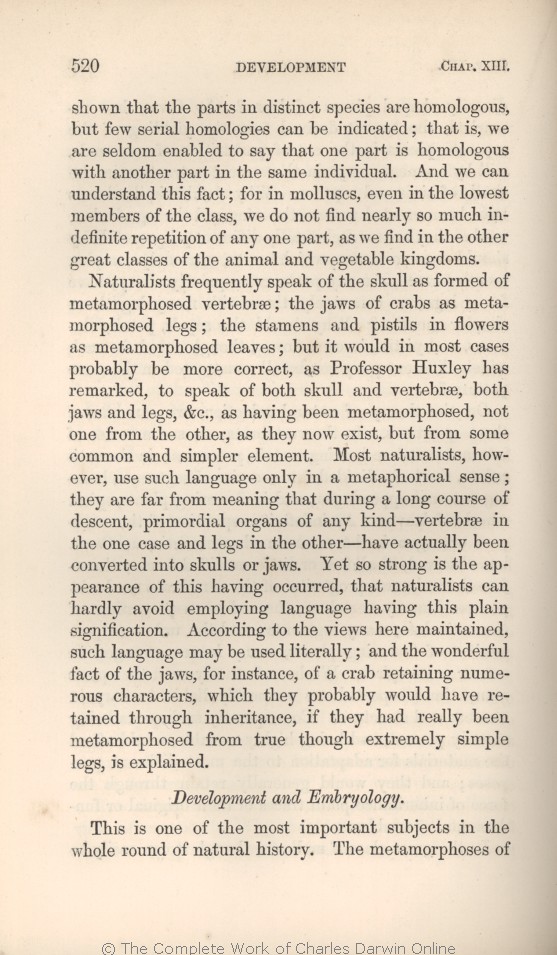parts
in | in 1869 1872 |
| of one species with those of another and 1859 |
| of one species with those of other and 1860 1861 1866 |
| species 1869 1872 | | species, 1859 1860 1861 1866 |
| are homologous, but 1869 |
| we can indicate but 1859 1860 1861 1866 |
| can be shown to be homologous, only a 1872 |
| homologies 1869 | | homologies; 1859 1860 1861 1866 | | homologies, 1872 |
| can be indicated; that 1869 |
| that 1859 1860 1861 1866 |
| such as the valves of Chitons, can be indicated; that 1872 |
| ..... 1869 1872 | | or organ 1859 1860 1861 1866 |
| part in 1869 1872 | | in 1859 1860 1861 1866 |
| part, 1859 1860 1861 1866 1869 | | part 1872 |
| 6 blocks not present in 1859 1860 1861 1866 1869; present in 1872 | | But morphology is a much more complex subject than it at first appears, as has lately been well shown in a remarkable paper by Mr. E. Ray Lankester, who has drawn an important distinction between certain classes of cases which have all been equally ranked by naturalists as homologous.
He proposes to call the structures which resemble each other in distinct animals, owing to their descent from a common progenitor with subsequent modification,
homogenous;
and the resemblances which cannot thus be accounted for, he proposes to call
homoplastic
. For instance, he believes that the hearts of birds and mammals are as a whole homogenous,— that is, have been derived from a common progenitor; but that the four cavities of the heart in the two classes are homoplastic,— that is, have been independently developed.
Mr. Lankester also adduces the close resemblance of the parts on the right and left sides of the body, and in the successive segments of the same individual animal; and here we have parts commonly called homologous, which bear no relation to the descent of distinct species from a common progenitor.
Homoplastic structures are the same with those which I have classed, though in a very imperfect manner, as analogous modifications or resemblances.
Their formation may be attributed in part to distinct organisms, or to distinct parts of the same organism, having varied in an analogous manner; and in part to similar modifications, having been preserved for the same general purpose or function,— of which many instances have been given.
|
|
|
Naturalists frequently speak of the skull as formed of metamorphosed
vertebræ; | vertebræ; 1869 1872 | | vertebræ: 1859 1860 1861 1866 |
| in 1869 1872 | | of 1859 1860 1861 1866 |
| most 1869 1872 | | these 1859 1860 1861 1866 |
| probably 1859 1860 1861 1866 1869 | probably 1872 |
| both 1859 1860 1861 1866 1869 | both 1872 |
| &c., 1866 1869 1872 | | &c.,— 1859 1860 1861 |
| other, 1859 1860 1861 1869 1872 | | other 1866 |
| as they now exist, but 1869 1872 |
| but 1859 1860 1861 |
| in their present state, but 1866 |
| and simpler element. 1866 1869 1872 |
| element. 1859 1860 1861 |
| Most naturalists, 1866 1869 1872 | | Naturalists, 1859 1860 1861 |
| sense; 1869 1872 | | sense: 1859 1860 1861 1866 |
| converted 1869 1872 | | modified 1859 1860 1861 1866 |
| this having 1869 1872 |
| a modification of this nature having 1859 1860 1861 |
| such modifications having actually 1866 |
| According to the views here maintained, such language 1869 1872 |
| On my view these terms 1859 1860 1861 1866 |
| probably would 1866 1869 1872 | | would probably 1859 1860 1861 |
| OMIT 1869 1872 |
| during a long course of descent 1859 1860 1861 1866 |
| though extremely simple legs, is 1869 |
| legs, or from some simple appendage, is 1859 1860 1861 |
| though simple legs, is 1866 |
| though extremely simple legs, is in part 1872 |
|
Development
|
Development
1869 | |
Embryology
1866 | |
Development
1872 |
|
Embryology
. 1869 | |
Development
. 1866 | |
Embryology.
1872 |
|
This is one of the most important
subjects in the whole round | subjects in the whole round 1869 1872 |
| departments 1866 |
| 1 blocks not present in 1859 1860 1861 1869; present in 1866 1872 | | Herein are included the ordinary
metamorphoses of insects, with which every one is familiar.
|
| The metamorphoses of insects, with which every one is familiar, 1869 |
| These 1866 |
|









